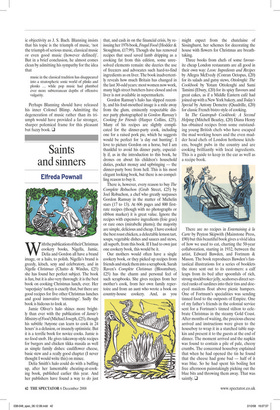Saints and sinners
Elfreda Pownall
With the publication of their Christmas cookery books, Nigella, Jamie, Delia and Gordon all have a brand image, or a halo, to polish. NigellaŌĆÖs brand is greedy, kitsch, sexy and celebratory, and in Nigella Christmas (Chatto & Windus, ┬Ż25) she has found her perfect subject. The book is fun, but it is also very thorough: it is the best book on cooking Christmas lunch, ever. Her ŌĆśsuperjuicyŌĆÖ turkey is exactly that, but there are good recipes for five other Christmas lunches and good innovative ŌĆśtrimmingsŌĆÖ. Sadly the book is hideous to look at.
Jamie OliverŌĆÖs halo shines more brightly than ever with the publication of JamieŌĆÖs Ministry of Food (Michael Joseph, ┬Ż25), though his subtitle ŌĆśAnyone can learn to cook in 24 hoursŌĆÖ is a delusion, or insanely optimistic. But it is a terrific book for novice cooks. Jamie is no food snob. He gives takeaway-style recipes for burgers and chicken tikka masala as well as simple family dishes: cauliflower cheese, basic stew and a really good chapter (I never thought I would write this) on mince.
Delia SmithŌĆÖs halo could do with a buffing up, after her lamentable cheating-at-cooking book, published earlier this year. And her publishers have found a way to do just that, and cash in on the financial crisis, by reissuing her 1976 book, Frugal Food (Hodder & Stoughton, ┬Ż17.99). Though she has removed recipes that used saved lamb dripping as a cooking fat from this edition, some unresolved elements remain: she decries the use of freezers and advocates such hard-to-find ingredients as ox liver. The book inadvertently reveals how much Britain has changed in the last 30-odd years: most women now work, many high street butchers have closed and ox liver is not available in supermarkets.
Gordon RamsayŌĆÖs halo has slipped recently, and his foul-mouthed image is a mile away from the glum, eminently respectable dinner party photographed in Gordon RamsayŌĆÖs Cooking for Friends (Harper Collins, ┬Ż25). Many of his recipes are slightly complicated for the dinner-party cook, including one for a raised pork pie, which he suggests would be perfect for ŌĆśa day out huntingŌĆÖ. I love to picture Gordon on a horse, but I am thankful to avoid his dinner party, especially if, as in the introduction to this book, he drones on about his childrenŌĆÖs household duties, pocket money and upbringing ŌĆö the dinner-party bore from hell. This is his most elegant looking book, but there is no compelling reason to buy it.
There is, however, every reason to buy The Complete Robuchon (Grub Street, ┬Ż25) by Joel Robuchon, a chef who greatly surpasses Gordon Ramsay in the matter of Michelin stars (17 to 13). At 606 pages and 800 firstrate recipes (though with no photographs or ribbon marker) it is great value. Ignore the recipes with expensive ingredients (foie gras) or rare ones (mirabelle plums); the majority are simple, delicious and cheap. I have cooked the best roast chicken, a delectable lemon tart, soups, vegetable dishes and sauces and stews, all superb, from this book. If I had to own just one cookery book, this would be it.
Our mothers would often have a single cookery book, or they picked up recipes from friends and stuck them into a scrapbook. Sarah RavenŌĆÖs Complete Christmas (Bloomsbury, ┬Ż25) has the charm and personal feel of such scrapbooks. She gives recipes from her motherŌĆÖs cook, from her own family repertoire and from an aunt who wrote a book on country-house cookery. And, as you might expect from the chatelaine of Sissinghurst, her schemes for decorating the house with flowers for Christmas are breathtaking.
Three books from chefs of some favourite cheap London restaurants are all good in their own way: Leon: Ingredients and Recipes by Allegra McEvedy (Conran Octopus, ┬Ż20) for its salads and gutsy stews, Ottolenghi: The Cookbook by Yotam Ottolenghi and Sami Tamimi (Ebury, ┬Ż20) for its spicy flavours and great cakes, as if a Middle Eastern caf├® had joined up with a New York bakery, and TodayŌĆÖs Special by Antony Demetre (Quadrille, ┬Ż20) for classic French bistro style of cooking.
In The Gastropub Cookbook: A Second Helping (Mitchell Beazley, ┬Ż20) Diana Henry has obtained recipes from some outstanding young British chefs who have escaped the mad working hours and the even madder head chefs of London hothouse kitchens, bought pubs in the country and are cooking brilliantly with local ingredients. This is a guide to keep in the car as well as a recipe book.
There are no recipes in Entertaining ├Ā la Carte by Peyton Skipwith (Mainstone Press, ┬Ż90) but this beautiful book gives a vivid idea of how we used to eat, charting the 50-year collaboration, starting in 1932, between the artist, Edward Bawden, and Fortnum & Mason. The book reproduces BawdenŌĆÖs fantastical illustrations for a series of booklets the store sent out to its customers: a calf leaps from its bed after spoonfuls of rich, strong stockbroker jelly, seahorses direct serried ranks of sardines into their tins and doeeyed maidens float above picnic hampers. One of FortnumŌĆÖs specialities was sending tinned food to the outposts of Empire. One of my fatherŌĆÖs friends in the colonial service sent for a FortnumŌĆÖs tinned stilton to celebrate Christmas in the steamy Gold Coast. After months of waiting, the precious cheese arrived and instructions were given to the houseboy to wrap it in a starched table napkin and present it to the guests at the end of dinner. The moment arrived and the napkin was found to contain a pile of pale, cheesy crumbs. The concerned houseboy explained that when he had opened the tin he found that the cheese had gone bad ŌĆö half of it was blue. So he had spent his boiling hot free afternoon painstakingly picking out the blue bits and throwing them away. That was saintly. ŌØæ


















































































 Previous page
Previous page